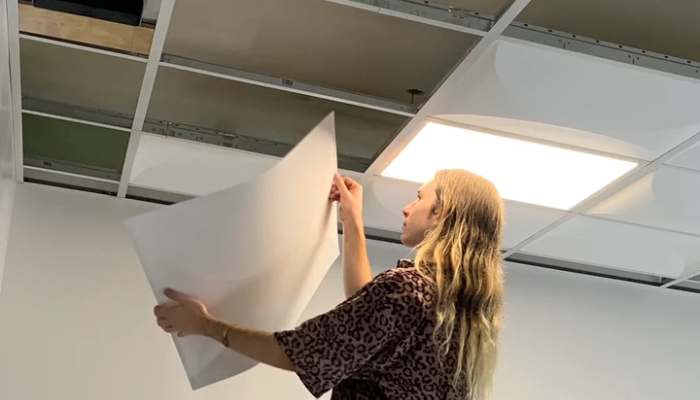“Tile Ceiling Tile Art Prisinor B-34897” refers to a remarkable and poignant artifact created under harrowing conditions during World War II. This unique piece of art, produced by an anonymous prisoner identified by the number B-34897, captures the intense emotions, struggles, and resilience of those held in concentration camps. More than just a simple ceiling tile, it stands as a testament to the power of artistic expression as a form of resistance and survival in the darkest of times.
In this article, we will dive deep into the history of Tile Ceiling Tile Art Prisinor B-34897, exploring the circumstances surrounding its creation, its symbolism, and the impact it has on our understanding of the human spirit in times of adversity.
The History Behind Tile Ceiling Tile Art Prisinor B-34897
The story of Tile Ceiling Tile Art Prisinor B-34897 begins in the brutal and inhumane environment of Nazi concentration camps during World War II. Identified only by their camp-issued number, prisoner B-34897 is thought to have created this tile as a way to preserve their identity, experiences, and perhaps even a sense of hope amidst unspeakable suffering. Prisoners often lost their names, but the numbers they were given became a new form of identity. The creation of art under such oppressive conditions was a powerful form of self-expression and resistance.
This piece of art, etched or painted onto a ceiling tile, was likely made with whatever scarce materials were available to the prisoner. The tile itself may have been part of the prison’s architecture, subtly altered by the artist to avoid detection by guards. The story behind this art reflects the resilience and ingenuity of prisoners in preserving a part of themselves in unimaginable conditions.
Symbolism in Tile Ceiling Tile Art Prisinor B-34897
The artwork of Tile Ceiling Tile Art Prisinor B-34897 holds deep symbolic meaning. Art produced in concentration camps was more than an aesthetic exercise; it was a form of silent defiance and an assertion of humanity. The ceiling tile, a mundane object within the confines of the camp, became a canvas on which the prisoner could express their feelings, thoughts, and identity.
One significant interpretation is that the ceiling tile represents the constant entrapment prisoners felt, both physically and mentally. The tile is a metaphor for being trapped beneath the weight of the oppressive regime. Yet, the act of creating art on this tile symbolizes a yearning for freedom—an escape, even if only in spirit. This piece serves as a permanent marker of the endurance and creativity that flourished even when the body was imprisoned.
The Significance of Art in Concentration Camps
Art in concentration camps served as a way for prisoners to maintain a sense of self amidst dehumanization. While art supplies were scarce and conditions intolerable, the act of creating art was a form of psychological survival. Tile Ceiling Tile Art Prisinor B-34897 is a striking example of how people used whatever materials they could find to leave their mark on history, even in situations of extreme duress.
Creating art helped preserve cultural memory and personal identity. Many prisoners turned to drawing, writing, and sculpting as ways to cope with their surroundings. These artistic endeavors were often carried out in secret and could be punishable by death if discovered. Nevertheless, they were a crucial form of rebellion, a way to cling to humanity and individuality in the face of mass persecution.
The Discovery and Preservation of Tile Ceiling Tile Art Prisoner B-34897
The discovery of Tile Ceiling Tile Art Prisinor B-34897 is a fascinating story in itself. Unearthed many years after the war, this piece of art was found in a forgotten corner of a dilapidated camp structure. Historians believe that such artwork was often overlooked because it was created in hidden or discreet locations, such as on ceiling tiles, walls, or furniture that was never meant to last.
Once discovered, efforts to preserve the tile were immediately undertaken. Due to its delicate nature and the emotional weight it carries, historians, art restorers, and curators have worked to ensure its longevity. This discovery opened a window into the everyday lives of concentration camp prisoners, offering a glimpse into the world of an artist who fought to preserve their identity through creativity.
Legacy and Impact of Tile Ceiling Tile Art Prisoner B-34897
The legacy of Tile Ceiling Tile Art Prisinor B-34897 extends beyond the walls of the concentration camp where it was created. Today, this piece serves as a haunting reminder of the power of art to transcend even the most inhumane conditions. Its influence is felt in modern exhibitions on Holocaust art, war history, and memorials dedicated to those who suffered during World War II.
Art created by prisoners like B-34897 continues to inspire people worldwide, reminding us of the human capacity for resilience. Museums and historians emphasize the significance of this artifact as a means of education, offering a personal perspective on the war that traditional historical narratives may overlook. As an educational tool, this tile has become a crucial element in preserving the memory of the Holocaust, teaching future generations about the importance of empathy, tolerance, and resistance.
Conclusion: A Tribute to Resilience Through Art
The story of Tile Ceiling Tile Art Prisinor B-34897 is not just a tale of artistic creation, but of survival, resistance, and the human spirit. As an artifact, it holds immense historical significance, giving voice to the otherwise voiceless victims of the Holocaust. Through its symbols and story, we are reminded of the power of art in maintaining one’s identity and humanity, even in the darkest moments of history. This unique tile will continue to stand as a powerful reminder of the enduring legacy of those who suffered, fought, and created under unimaginable circumstances.
FAQs
- What is the significance of tile ceiling tile art prisoner B-34897?
Tile ceiling tile art prisoner B-34897 is a rare artifact created by a concentration camp prisoner during World War II. It represents the prisoner’s defiance, resilience, and creativity in a place of extreme suffering. - Who was prisoner B-34897?
The true identity of prisoner B-34897 remains unknown. The number B-34897 represents their assigned concentration camp number, which replaced their personal identity under Nazi oppression. - How was the art created on a ceiling tile?
It is believed that the prisoner used whatever materials were available within the camp, such as charcoal or improvised pigments, to etch or paint the artwork onto the tile. - Why is the ceiling tile important in this context?
The ceiling tile is symbolic of the physical and psychological entrapment experienced by concentration camp prisoners. By turning this mundane object into art, the prisoner demonstrated a refusal to be completely dehumanized. - Where was this tile discovered?
The tile was discovered years after World War II in an abandoned section of a former concentration camp, where it had been hidden or overlooked. - What does this piece of art tell us about concentration camp life?
It provides a deeply personal glimpse into the emotional and psychological state of prisoners, highlighting their resourcefulness and the importance of art as a coping mechanism. - How has the tile been preserved?
After its discovery, historians and art restorers have worked to protect the fragile tile and ensure that it remains intact for future generations. - Is this tile art displayed in any museums?
Yes, it has been featured in Holocaust museums and art exhibitions focused on war history and the role of art in preserving memory. - What other forms of art were created in concentration camps?
Prisoners created drawings, paintings, poems, and even musical compositions, often using scarce materials and in secret to avoid punishment. - Why is prisoner art important to historical understanding?
Prisoner art offers a personal, emotional connection to historical events, providing a different perspective than official records or photographs. It humanizes the victims and serves as a reminder of the power of creativity amidst suffering




